The Universe
Period of Revolution – Engineersfield
The science which deals with the study of heavenly bodies in respect of their motions, positions and compositions is known as astronomy. The Sun around which the planets revolve is a star. It is one of the hundred billion stars that comprise our galaxy called the Milky Way. A vast collection of stars held together by mutual gravitation is called a galaxy. The billions of such galaxies form the universe. Hence,the Solar system, stars and galaxies are the constituents of the universe.
The Solar system
The part of the universe in which the Sun occupies the central position of the system holding together all the heavenly bodies such as planets, moons, asteroids, comets … etc., is called Solar system. The gravitational attraction of the Sun primarily governs the motion of the planets and other heavenly bodies around it. Mercury, Venus, Earth, Mars, Jupiter, Saturn, Uranus, Neptune and Pluto are the nine planets that revolve around the Sun. We can see the planet Venus in the early morning in the eastern sky or in the early evening in the western sky. The planet Mercury can also be seen sometimes after the sunset in the West or just before sunrise in the East. From the Earth, the planet Mars was visibly seen on 27th August 2003. The planet Mars came closer to the Earth after 60,000 years from a distance of 380 × 106 km to a nearby distance of 55.7 × 106 km. It would appear again in the year 2287. Some of the well known facts about the solar system have been summarised in the Table below.
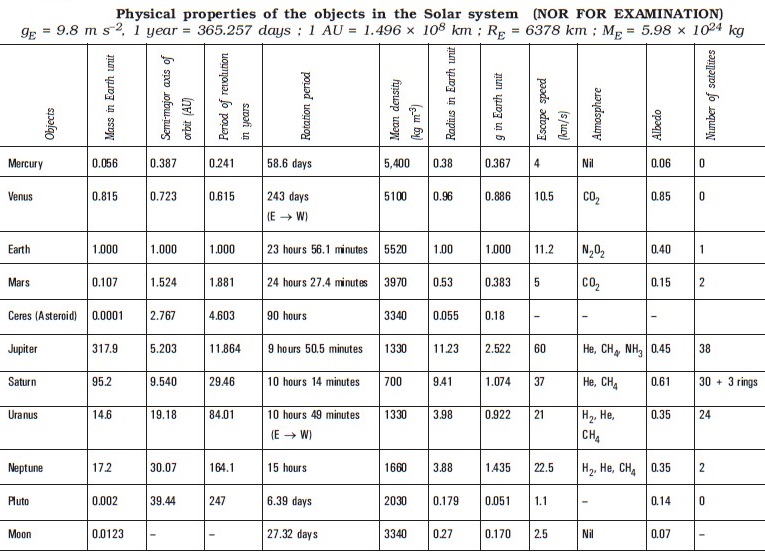
Planetary motion
The ancient astronomers contributed a great deal by identifying the planets in the solar system and carefully plotting the variations in their positions of the sky over the periods of many years. These data eventually led to models and theories of the solar system. The first major theory, called the Geo-centric theory was developed by a Greek astronomer, Ptolemy. The Earth is considered to be the centre of the universe, around which all the planets, the moons and the stars revolve in various orbits. The great Indian Mathematician and astronomer Aryabhat of the 5th century AD stated that the Earth rotates about its axis. Due to lack of communication between the scientists of the East and those of West, his observations did not reach the philosophers of the West. Nicolaus Copernicus, a Polish astronomer proposed a new theory called Helio-centric theory. According to this theory, the Sun is at rest and all the planets move around the Sun in circular orbits. A Danish astronomer Tycho Brahe made very accurate observations of the motion of planets and a German astronomer Johannes Kepler analysed Brahe’s observations carefully and proposed the empirical laws of planetary motion.
Kepler’s laws of planetary motion
The law of orbits Each planet moves in an elliptical orbit with the Sun at one focus.
A is a planet revolving round the Sun. The position P of the planet where it is very close to the Sun is known as perigee and the position
Q of the planet where it is farthest from the Sun is known as apogee.
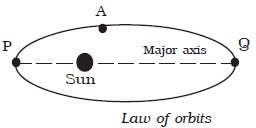
The law of areas
The line joining the Sun and the planet (i.e radius vector) sweeps ut equal areas in equal interval of times.
The orbit of the planet around the Sun is as shown in Fig. below. The areas A1 and A2 are swept by the radius vector in equal times. The planet covers unequal distances S1 and S2 in equal time. This is due to the variable speed of the planet. When the planet is closest to the Sun, it covers greater distance in a given time. Hence, the speed is maximum at the closest position. When the planet is far away from the Sun, it covers lesser distance in the same time. Hence the speed is minimum at the farthest position
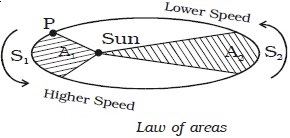
Proof for the law of areas
Consider a planet moving from A to B. The radius vector OA sweeps a small angle dθ at the centre in a small interval of time dt. From the Fig. 4.18, AB = rd θ. The small area dA swept by the radius is,
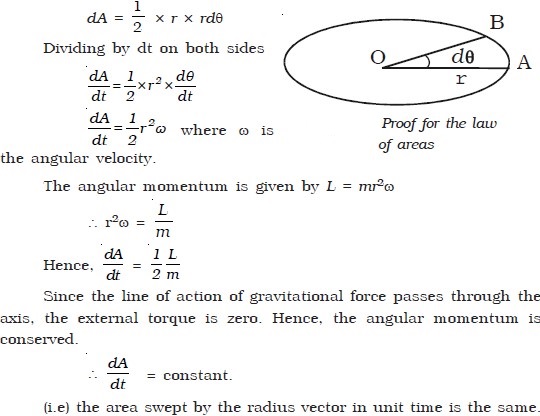
The law of periods
The square of the period of revolution of a planet around the Sun is directly proportional to the cube of the mean distance between the planet and the Sun.
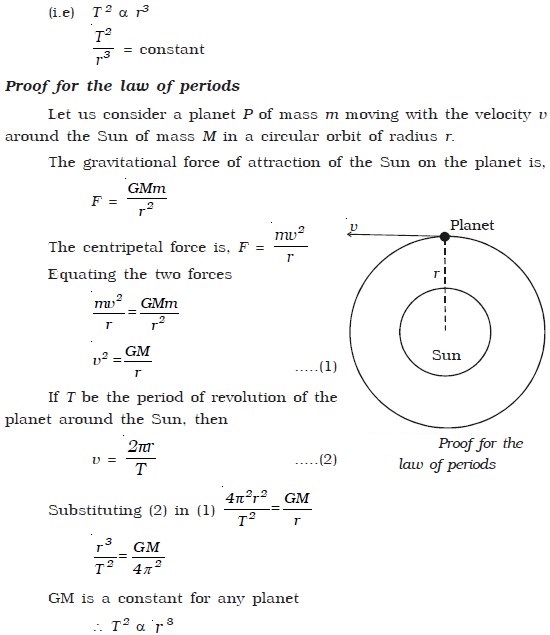
Distance of a heavenly body in the Solar system
The distance of a planet can be accurately measured by the radar echo method. In this method, the radio signals are sent towards the planet from a radar. These signals are reflected back from the surface of a planet. The reflected signals or pulses are received and detected on Earth. The time t taken by the signal in going to the planet and coming back to Earth is noted. The signal travels with the velocity of the light c. The distance s of the planet from the Earth is given by s = ct/2
Size of a planet
It is possible to determine the size of any planet once we know the distance S of the planet. The image of every heavenly body is a disc when viewed through a optical telescope. The angle θ between two extreme points A and B on the disc with respect to a certain point on the Earth is determined with the help of a telescope. The angle θ is called the angular diameter of the planet. The linear diameter d of the planet is then given by
d = distance × angular diameter
d = s × θ
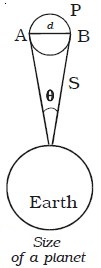
Surface temperatures of the planets
The planets do not emit light of their own. They reflect the Sun’s light that falls on them. Only a fraction of the solar radiation is absorbed and it heats up the surface of the planet. Then it radiates energy. We can determine the surface temperature T of the planet using Stefan’s law of radiation E = σ T4 where σ is the Stefan’s constant and E is the radiant energy emitted by unit area in unit time.
In general, the temperature of the planets decreases as we go away from the Sun, since the planets receive less and less solar energy according to inverse square law. Hence, the planets farther away from the Sun will be colder than those closer to it. Day temperature of Mercury is maximum (340oC) since it is a planet closest to the Sun and that of Pluto is minimum (−240oC). However Venus is an exception as it has very thick atmosphere of carbon−di−oxide. This acts as a blanket and keeps its surface hot. Thus the temperature of Venus is comparitively large of the order of 480oC.
Mass of the planets and the Sun
In the universe one heavenly body revolves around another massive heavenly body. (The Earth revolves around the Sun and the moon revolves around the Earth). The centripetal force required by the lighter body to revolve around the heavier body is provided by the gravitational force of attraction between the two. For an orbit of given radius, the mass of the heavier body determines the speed with which the lighter body must revolve around it. Thus, if the period of revolution of the lighter body is known, the mass of the heavier body can be determined. For example, in the case of Sun − planet system, the mass of the Sun M can be calculated if the distance of the Sun from the Earth r, the period of revolution of the Earth around the Sun T and the gravitational constant G are known using the relation M = 4π2/G 3r/T2
Atmosphere
The ratio of the amount of solar energy reflected by the planet to that incident on it is known as albedo. From the knowledge of albedo, we get information about the existence of atmosphere in the planets. The albedo of Venus is 0.85. It reflects 85% of the incident light, the highest among the nine planets. It is supposed to be covered with thick layer of atmosphere. The planets Earth, Jupiter, Saturn, Uranus and Neptune have high albedoes, which indicate that they possess atmosphere. The planet Mercury and the moon reflect only 6% of the sunlight. It indicates that they have no atmosphere, which is also confirmed by recent space probes.
There are two factors which determine whether the planets have atmosphere or not. They are (i) acceleration due to gravity on its surface and (ii) the surface temperature of the planet. The value of g for moon is very small (¼th of the Earth). Consequently the escape speed for moon is very small. As the average velocity of the atmospheric air molecules at the surface temperature of the moon is greater than the escape speed, the air molecules escape.
Mercury has a larger value of g than moon. Yet there is no atmosphere on it. It is because, Mercury is very close to the Sun and hence its temperature is high. So the mean velocity of the gas molecules is very high. Hence the molecules overcome the gravitational attraction and escape.
Conditions for life on any planet
The following conditions must hold for plant life and animal life to exist on any planet.
(i) The planet must have a suitable living temperature range.
(ii) The planet must have a sufficient and right kind of atmosphere.
(iii) The planet must have considerable amount of water on its surface.
Other objects in the Solar system
Asteroids
Asteroids are small heavenly bodies which orbit round the Sun between the orbits of Mars and Jupiter. They are the pieces of much larger planet which broke up due to the gravitational effect of Jupiter. About 1600 asteroids are revolving around the Sun. The largest among them has a diameter of about 700 km is called Ceres. It circles the Sun
once in every 4½ years.
Comets
A comet consists of a small mass of rock−like material surrounded by large masses of substances such as water, ammonia and methane. These substances are easily vapourised. Comets move round the Sun in highly elliptical orbits and most of the time they keep far away from the Sun. As the comet approaches the Sun, it is heated by the Sun’s radiant energy and vapourises and forms a head of about 10000 km in diameter. The comet also develops a tail pointing away from the Sun. Some comets are seen at a fixed regular intervals of time. Halley’s comet is a periodic comet which made its appearance in 1910 and in 1986. It would appear again in 2062.
Meteors and Meteorites
The comets break into pieces as they approach very close to the Sun. When Earth’s orbit cross the orbit of comet, these broken pieces fall on the Earth. Most of the pieces are burnt up by the heat generated due to friction in the Earth’s atmosphere. They are called meteors (shooting stars). We can see these meteors in the sky on a clear moonless night. Some bigger size meteors may survive the heat produced by friction and may not be completely burnt. These blazing objects which manage to reach the Earth are called meteorites. The formation of craters on the surface of the moon, Mercury and Mars is due to the fact that they have been bombarded by large number of meteorites.
Stars
A star is a huge, more or less spherical mass of glowing gas emitting large amount of radiant energy. Billions of stars form a galaxy. There are three types of stars. They are (i) double and multiple stars (ii) intrinsically variable stars and (iii) Novae and super novae. In a galaxy, there are only a few single stars like the Sun. Majority of the stars are either double stars (binaries) or multiple stars. The binary stars are pairs of stars moving round their common centre of gravity in stable equilibrium. An intrinsically variable star shows variation in its apparent brightness. Some stars suddenly attain extremely large brightness, that they may be seen even during daytime and then they slowly fade away. Such stars are called novae. Supernovae is a largenovae. The night stars in the sky have been given names such as Sirius (Vyadha), Canopas (Agasti), Spica (Chitra), Arcturus (Swathi), Polaris (Dhruva) … etc. After the Sun, the star Alpha Centauri is nearest to Earth.
Sun
The Sun is extremely hot and self−luminous body. It is made of hydrogeneous matter. It is the star nearest to the Earth. Its mass is about 1.989 × 1030 kg. Its radius is about 6.95 × 108 m. Its distance from the Earth is 1.496 × 1011 m. This is known as astronomical unit (AU). Light of the sun takes 8 minutes 20 seconds to reach the Earth. The gravitational force of attraction on the surface of the Sun is about 28 times that on the surface of the Earth. Sun rotates about its axis from East to West. The period of revolution is 34 days at the pole and 25 days at the equator. The density of material is one fourth that of the Earth. The inner part of the Sun is a bright disc of temperature 14 × 106 K known as photosphere. The outer most layer of the Sun of temperature 6000 K is called chromosphere.
Constellations
Most of the stars appear to be grouped together forming interesting patterns in the sky. The configurations or groups of star formed in the patterns of animals and human beings are called constellations. There are 88 constellations into which the whole sky has been divided. If we look towards the northern sky on a clear moonless night during the months of July and August, a group of seven bright stars resembling a bear, the four stars forming a quadrangle form the body, the remaining three stars make the tail and some other faint stars form the paws and head of the bear. This constellation is called Ursa Majoror Saptarishi or Great Bear. The constellation Orion resembles the figure of a hunter and Taurus (Vrishabha) resembles the shape of a bull.
Galaxy
A large band of stars, gas and dust particles held together by gravitational forces is called a galaxy. Galaxies are really complex in nature consisting of billions of stars. Some galaxies emit a comparatively small amount of radio radiations compared to the total radiations emitted. They are called normal galaxies. Our galaxy Milky Way is a normal galaxy spiral in shape. The nearest galaxy to us known as Andromeda galaxy, is also a normal galaxy. It is at a distance of 2 × 106 light years. (The distance travelled by the light in one year [9.467 × 1012 km] is called light year). Some galaxies are found to emit millions of times more radio waves compared to normal galaxies. They are called radio galaxies.
Milky Way galaxy
Milky Way looks like a stream of milk across the sky. Some of the important features are given below.
Shape and size
Milky Way is thick at the centre and thin at the edges. The diameter of the disc is 105 light years. The thickness of the Milky Way varies from 5000 light years at the centre to 1000 light years at the position of the Sun and to 500 light years at the edges. The Sun is at a distance of about 27000 light years from the galactic centre.
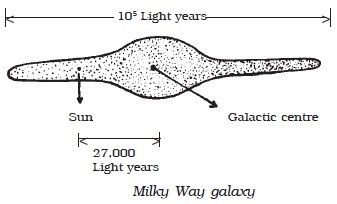
Interstellar matter
The interstellar space in the Milky Way is filled with dust and gases called inter stellar matter. It is found that about 90% of the matter is in the form of hydrogen.
Clusters
Groups of stars held by mutual gravitational force in the galaxy are called star clusters. A star cluster moves as a whole in the galaxy. A group of 100 to 1000 stars is called galactic cluster. A group of about10000 stars is called globular cluster.
Rotation
The galaxy is rotating about an axis passing through its centre. All the stars in the Milky Way revolve around the centre and complete one revolution in about 300 million years. The Sun, one of the many stars revolves around the centre with a velocity of 250 km/s and its period of revolution is about 220 million years.
Mass
The mass of the Milky Way is estimated to be 3 × 1041 kg.
The following three theories have been proposed to explain the origin of the Universe.
Big Bang theory
According to the big bang theory all matter in the universe was concentrated as a single extremely dense and hot fire ball. An explosion occured about 20 billion years ago and the matter was broken into pieces, thrown off in all directions in the form of galaxies. Due to continuous movement more and more galaxies will go beyond the boundary and will be lost. Consequently, the number of galaxies per unit volume will go on decreasing and ultimately we will have an empty universe.
Pulsating theory
Some astronomers believe that if the total mass of the universe is more than a certain value, the expansion of the galaxies would be stopped by the gravitational pull. Then the universe may again contract. After it has contracted to a certain critical size, an explosion again occurs. The expansion and contraction repeat after every eight billion years. Thus we may have alternate expansion and contraction giving rise to a pulsating universe.
Steady state theory
According to this theory, new galaxies are continuously created out of empty space to fill up the gap caused by the galaxies which escape from the observable part of the universe. This theory, therefore suggests that the universe has always appeared as it does today and the rate of expansion has been the same in the past and will remain the same in future. So a steady state has been achieved so that the total number of galaxies in the universe remains constant.

